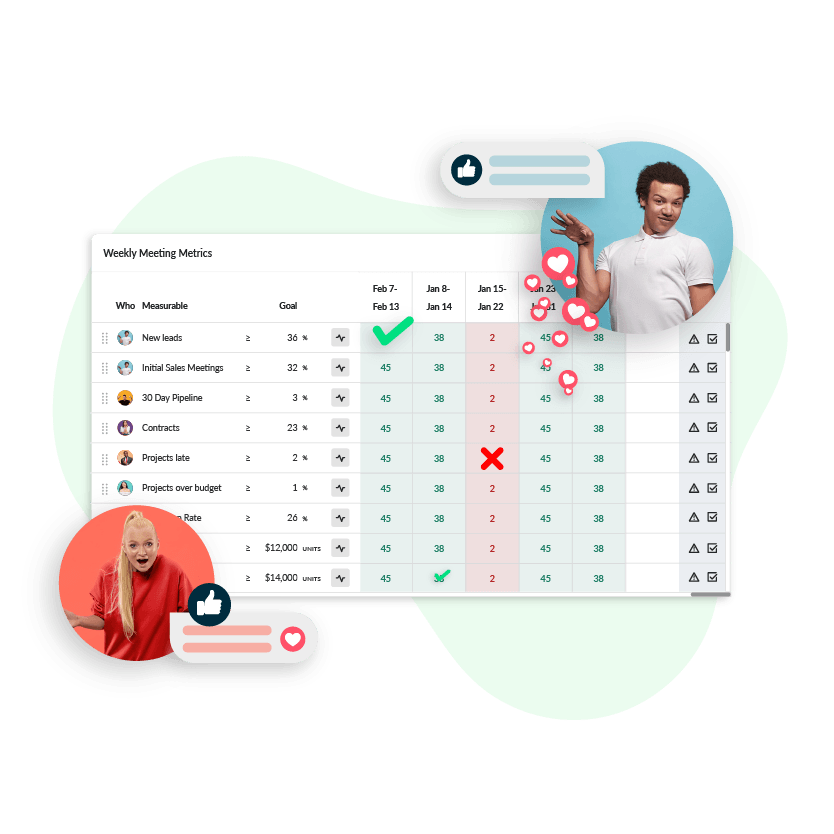We earn from qualifying purchases from Amazon Associate links.
Introducing the goal lifecycle
The lifecycle of a goal is the process of setting, monitoring and achieving your business goals from start to finish. The goal’s lifecycle begins with planning because the first step is to set clear targets for your team members to work towards. From there, you can use goal-tracking software or templates to monitor progress throughout the cycle until the objective has been achieved. By using the practical goal-tracking tools and techniques in this blog post, business leaders can ensure that their team members stay on track while also gaining insights into what works best for future projects.
The planning stage—SMART goals
Setting SMART goals—Specific, Measurable, Achievable, Relevant and Time-bound—is essential for business owners to ensure that their team members have clear objectives to work towards. SMART goals provide a framework to track progress over time and measure success. By setting measurable goals with achievable timelines, teams can better manage resources and increase the chances of meeting business objectives.
This is a quick overview of SMART goals before we take a closer look at some examples.
- Set specific objectives: Make sure your goals are specific by including target numbers, your target audience, and a precise aim in your goal-setting process.
- Create measurable milestones: Break down the goal into smaller milestones or tasks that can be tracked along the way to measure progress easily.
- Assess achievability: Consider the resources and capabilities of your team when setting business objectives so they’re achievable within the specified time frame.
- Ensure relevance: Check if the goal aligns with business objectives and company values to ensure it’s relevant to your business’s success.
- Set time boundaries: Setting clear timelines for each step of the goal-setting cycle will help your team stay on track and motivate team members throughout the process while achieving desired results on time.
Turning a goal into a measurable metric:
Start with a goal statement: Start by clearly defining your business goal, including any relevant context or background information. Make sure to use actionable language that’s both measurable and time-bound.
For example: “Increase website traffic from France by 10% over the next three months.”
Measurable success criteria: Detail what it takes to meet your goal and quantify it with clear metrics and target numbers. This will help you measure progress and success accurately.
For example, you can track progress by measuring website traffic from France using Google Analytics data reports weekly. In this example, we’ll need to see a 0.75% increase in traffic from France each week to meet this goal.
Break down milestones: Divide the project into smaller sections or tasks to be completed in stages, making it easier to track progress and adjust if necessary. Set realistic monthly targets to reach the overall goal of increasing website traffic from that specific country by 10%.
In this example, the target would be a 3.3% increase each month.
Examples of campaigns that could help reach this goal:
- Create country-specific content such as articles, blog posts and videos, focusing on French topics to draw a local audience.
- Expand social media presence by targeting French users on relevant networks like Facebook and Twitter.
- Contact bloggers and influencers in France for collaborations or endorsements of your business’s products or services.
- Start running targeted ad campaigns in search engines like Google with keywords tailored toward the French market segments you’re targeting.
- Set up retargeting campaigns using cookies to track users who have visited your website from France before, allowing you to advertise your business more effectively when they return.
- Utilize SEO optimization tactics such as backlinking, keyword research & optimization, etc., specific to the target region and language.
- Focus on improving customer service experiences by offering multilingual support options specifically catered towards customers from France.
- Share newsworthy developments on business websites/magazines relevant to the French market.
- Investigate potential partnerships with businesses in similar industries but with established audiences in France.
Check relevance: Confirm that your business goals align with company values and objectives to ensure their relevance to your business’s success.
Create time boundaries: Set clear timelines for each stage of the goal lifecycle to keep teams on track and motivated while achieving desired results on time.
For example, set deadlines for tracking progress every two weeks to stay on track with our ultimate goal of increasing monthly website traffic from France by 10% over three months.
Execution & tracking—Using goal-tracking software and templates
Execution of business goal planning can be facilitated with the use of goal-tracking software and templates. Goals should not only be set but also tracked over time. This is where templates and software come in handy.
Goal-tracking software can help you monitor your team’s progress and ensure they meet their desired milestones, ensuring the project is completed within the allotted time frame. With this kind of software, you and your business’s owners can track progress on short-term tasks and long-term goals and quickly adjust their plans if needed.
Streamline your goals today with the Bloom Growth™ business plan organizer.
Goal tracking templates—The scorecard
Business owners can use a scorecard to make monitoring team metrics even easier. A scorecard is a template for monitoring metrics that provides a more standardized format for goal setting and tracking, allowing business owners to input data quickly—without creating an entire system from scratch. Additionally, our software comes bundled with the business plan template so business owners can start defining and reaching their organization’s goals.
Business goal planning becomes much simpler and more efficient when business owners utilize software and templates for execution and tracking. Not only do these tools save time by providing a standardized template format, but they also provide business owners with better visibility into progress toward their goals so that they can pivot quickly if needed.

Analyzing progress
Once business owners have set a goal and put the tracking system in place, it’s time to analyze progress. By consistently assessing progress towards goals, business owners can identify areas where the plan may need adjustment.
For example: If monthly website traffic from France has not increased by 10% within three months, analyze which campaigns were most or least successful and tailor future efforts using these findings.
Continuing with the France example, here are some example questions to ask when analyzing metrics:
- What is the current website traffic from France?
- What are the current conversion rates for visitors from France?
- Are there any areas of the website that are underperforming for French visitors?
- Are there any other websites or competitors which are performing better than we are in France?
- How can we optimize our website content and design to increase engagement with French visitors?
- What strategies can we use to increase our visibility on search engines in France?
- Are there any new marketing channels we should consider targeting in France?
- How can we measure the success of our efforts over the next three months?
By carefully analyzing progress and making necessary adjustments to existing plans, business owners can ensure their business goals are met efficiently.
Fine-tuning your goals
It’s important to remember that goals are not set in stone. Clients and current events are constantly changing and evolving, so it’s important to be flexible with your goals and adjust them as needed. Pivoting may be what your goals need to stay on track. If you find yourself stuck on a goal or feeling like you’re not making progress, it might be beneficial to try something new. Changing your goals can be difficult but sometimes necessary to keep moving forward. Take the time to evaluate your goals and determine if they’re still relevant—this will be a game changer for the life of your goals.
Questions to ask yourself when tracking long-term goals:
- What progress have I made towards my goal?
- Are there any new developments that could impact my goal?
- Am I still motivated to reach my goal?
- Have I identified any potential obstacles or roadblocks?
- Is the timeline for achieving my goal still realistic?
- Are there any new resources or tools that could help me reach my goal faster, and how can I effectively utilize them?
- Do I need to adjust my strategy to stay on track?
- Are there any areas where I can improve my performance?
- Can anyone provide me with feedback and guidance on how to reach my goal?
Celebrating the achievement of goals
An essential part of goal-setting is recognizing and rewarding yourself for your hard work and dedication when you have achieved a goal. Celebrating success can help motivate you to continue striving for more and provide a sense of accomplishment and pride.
Celebrations can range from simple gestures such as verbal recognition or a crisp high-five to more significant events such as parties or awards ceremonies. Additionally, celebrating successes with others can create a sense of camaraderie and foster motivation in the workplace. Taking time to celebrate successes helps create a culture of encouragement and appreciation, leading to further success.
Wrapping up—how to make sure you achieve your goals every time
Achieving your goals may be challenging, but it can be done if you take the time to understand the life cycle of a goal. By understanding the stages of discovery, setup, execution, review and closure, you can ensure that you take all the necessary steps to reach your desired outcome. With careful planning and nurturing of your goals, you can make sure that every goal you set is achieved.

